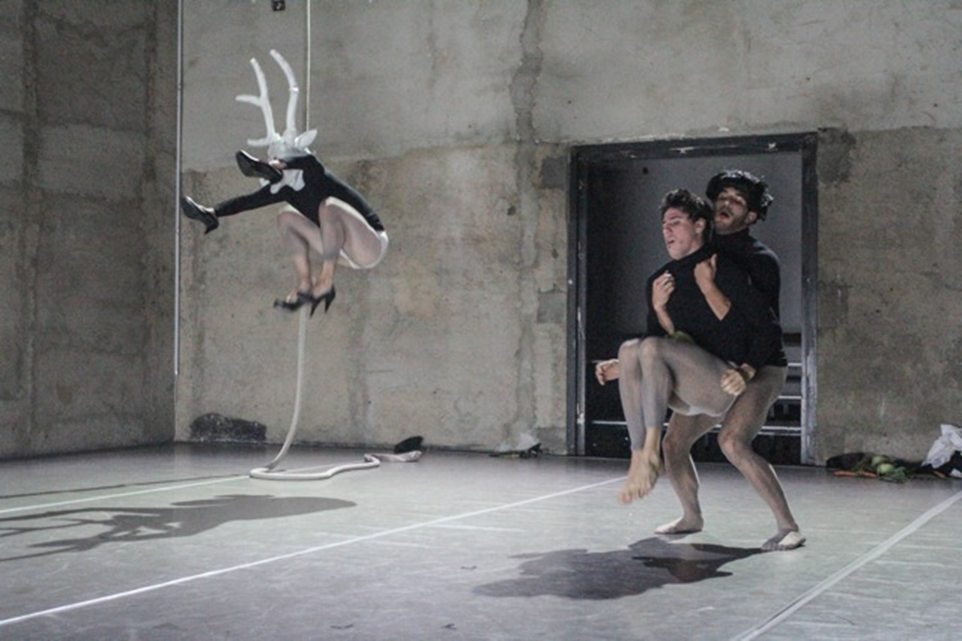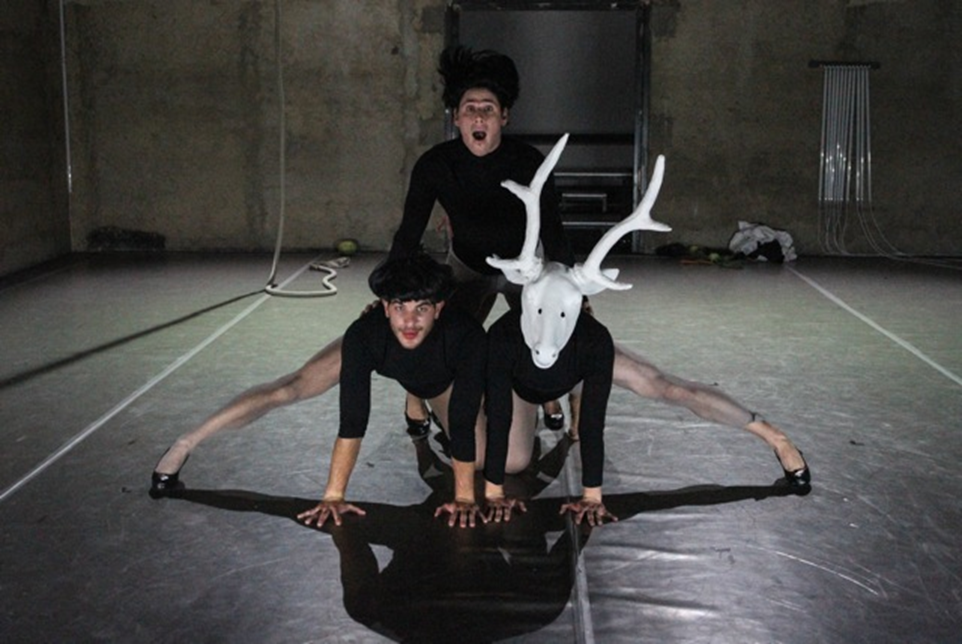Hell is a metaphor of archetypal dimensions, there is no religion or culture that would not work with its analogies and as an indication of a particular state it may have many meanings for everyone. The authors have chosen one of the logical points of view: Hell is not a place, but rather a state of mind and soul, a condition in which we may sink alive, state of despair and loneliness, the fear of seeing our own nature. "Hell not after death, but here and now. Hell in the human heart, in the human soul. Hell of hopelessness. Hell as missing the goal, as missing oneself, not finding oneself (one of the possible translations of the word ,sin' is ,to miss the goal'.) Hell of pride. Hell of selfishness. Hell of indifference. Hell of withdrawal into oneself. Hell of blindness." Dante's verses (in a modern translation by Vladimír Mikeš) are indeed recited throughout the production by the actors – guides. At first it seems that the roles are clearly distributed, David Prachař takes on the role of the pilgrim and Lucie Trmíková that of his guide. But she does not quote only the words of the poet Virgil, but also those of Beatrice, she even becomes a materialized horror, the gates of hell. Stage speech, most of the time amplified by microphones, at some points soft, at others exalted, transforms into nearly unintelligible screams tearing our ears up or into cacophonous singing to the sound of the electric guitar. Horror and hatred combined flood the entire space. Dancers imprisoned there go through all nine circles of Inferno that the poet and his guide passed, to become partakers, symbols, victims and criminals. Movement vocabulary in this production is surprisingly relaxed and beautiful at the same time. The real horror stems from words rather than the stage images that the dancers create in front of us. After all, in a hell like this we would not be scared that much, it is deceptively pleasant in a way (still there is a reason behind the saying that the road to it is short and straight). The choreography, created by all the dancers (Václav Kuneš, Nataša Novotná, Štěpán Pechar and Alexandr Volný, who alternates with Milan Odstrčil) can be described as physical theatre rather than dance. As for the description of the infernal torments, the literary source is realistic, even naturalistic. The choreography, however, does not incline towards a mere imitation of the source, it rather focuses on some particular feature, which it further develops and builds around it an entire scene full of absurdity.
A Trip to Hell with 420PEOPLE? Why not
The company 420PEOPLE once again embarked on a journey of cooperation across theatrical genres and together with director Jan Nebeský and actors Lucie Trmíková and David Prachař mounted a production Inferno – Variations on Dante. They invited the audiences into the depths of hell in a somewhat shabby industrial premises of Teatro NoD that harmonized well with the production and showed them their own version of the dark places once described by Dante Alighieri in the Divine Comedy.
The production starts in a somewhat restrained manner with the scene full of indifference and manipulation, gentle movements and looks of resignation. Anyway, the tempo of the production soon intensifies, one scene follows another immediately and the depictions of grotesque relationships get more and more intense. From the depressingly looking scenes stands out the one of a mountain made of chairs, accompanied by a female monologue about meetings between Christ and the Devil. Inferno challenges gender stereotypes and in this way perhaps refers to the topic of losing one’s own identity as well, which is one of the most critical moments in life at any age. Dancers, regardless of gender, walk around the stage in black wigs, tights, on spike heels and their lips painted red. Each of them puts into his or her performance something of their individual attitude to movement. Saša Volný performs some acrobatic numbers with a rope, in the other dancers we can 'read' movements that are inherent to their bodies. There is also an animal mask and a rather morbid lighting with fluorescent tubes that the artists move around the stage and create their own live lighting design.  Performers gather into grotesque formations, manipulate the others or regard them with chilling indifference, they present all worldly sins we can think of, but without any cruelty and obscenity. At some points the stylization is so pleasant that we would almost forget that we were actually in hell, if it was not for the actors shouting their monologues. In their trance they appear more scary than the dancers. The production works as a solid piece, just the beginning is perhaps somewhat slow up to the point where it finds the right rhythm. It is not excessively fragmented, because the spoken word connects one section to another, while the dancers have to change costumes or get the props ready. Music by Jan Šikl is a blend of electronic sounds, a medley of particular materials and guitar solos alike, it changes volume and co-directs the dynamics of the production, because the author himself performs it at his music board. Bringing all elements together here and now works in this production really well. A moment of silence before the final applause shows that the audiences feel the need to sort their impressions and let them linger for a while. Anyone can find his or her own hell in Inferno – Variations on Dante, it does not necessarily have to be the hell of middle-aged people that, according to the authors, stands second only to the literary source. It is open to interpretations and associations that the audiences can make themselves according to their age and frame of mind. 420PEOPLE will guide them through safely anyway.
Performers gather into grotesque formations, manipulate the others or regard them with chilling indifference, they present all worldly sins we can think of, but without any cruelty and obscenity. At some points the stylization is so pleasant that we would almost forget that we were actually in hell, if it was not for the actors shouting their monologues. In their trance they appear more scary than the dancers. The production works as a solid piece, just the beginning is perhaps somewhat slow up to the point where it finds the right rhythm. It is not excessively fragmented, because the spoken word connects one section to another, while the dancers have to change costumes or get the props ready. Music by Jan Šikl is a blend of electronic sounds, a medley of particular materials and guitar solos alike, it changes volume and co-directs the dynamics of the production, because the author himself performs it at his music board. Bringing all elements together here and now works in this production really well. A moment of silence before the final applause shows that the audiences feel the need to sort their impressions and let them linger for a while. Anyone can find his or her own hell in Inferno – Variations on Dante, it does not necessarily have to be the hell of middle-aged people that, according to the authors, stands second only to the literary source. It is open to interpretations and associations that the audiences can make themselves according to their age and frame of mind. 420PEOPLE will guide them through safely anyway.
Review of the performance on September 30th, 2014 at Experimental Space NoD.
Inferno – Variations on Dante
Directed by: Jan NebeskýWritten by: Lucie Trmíková
Music: Jan Šikl
Choreography: Václav Kuneš and the dancers
Costumes: Petra Vlachynská
Lighting design: Jan Mlčoch
Pictures: Pavel Hejný, Fabiana Mertová
Premiere: September 30th, 2014 at Experimental Space NoD
Translation: Tomáš Valníček



